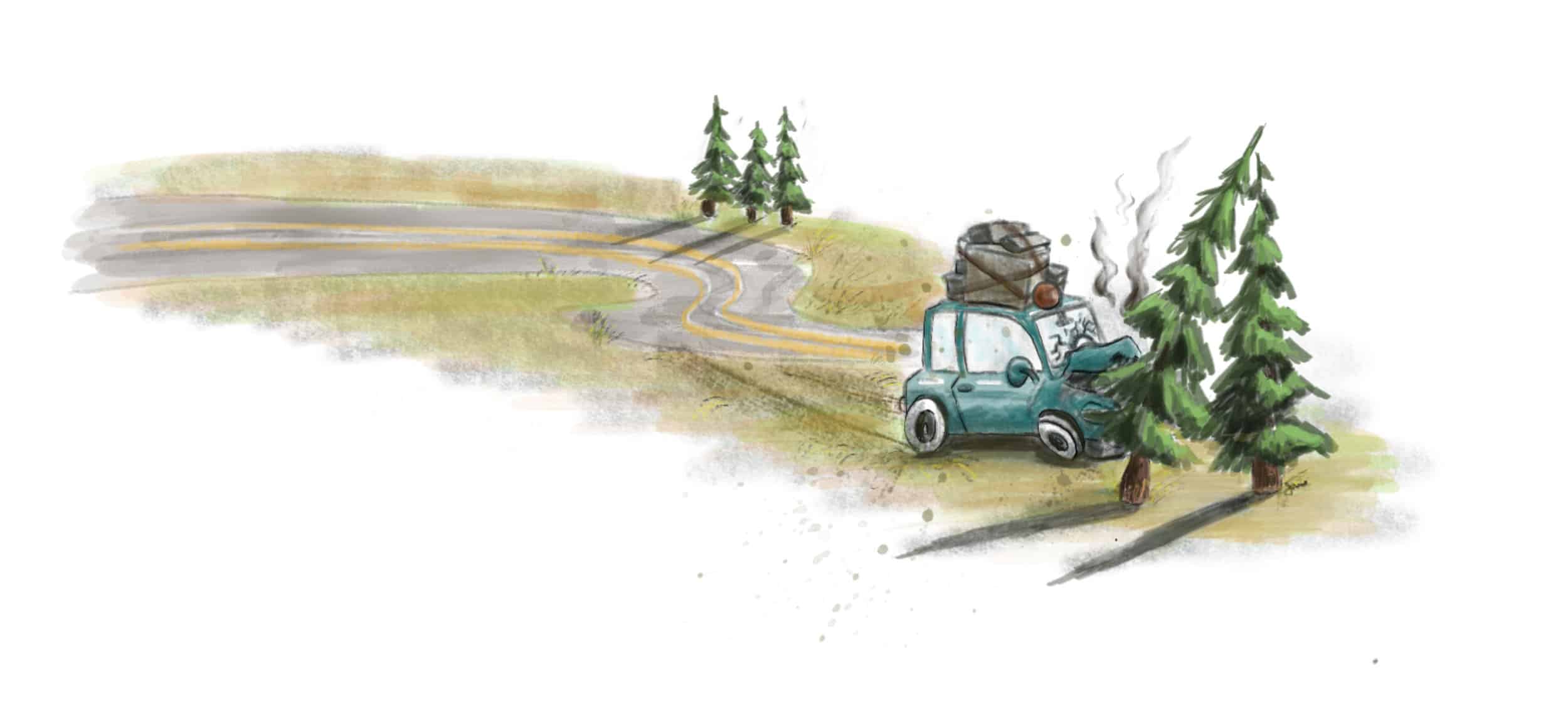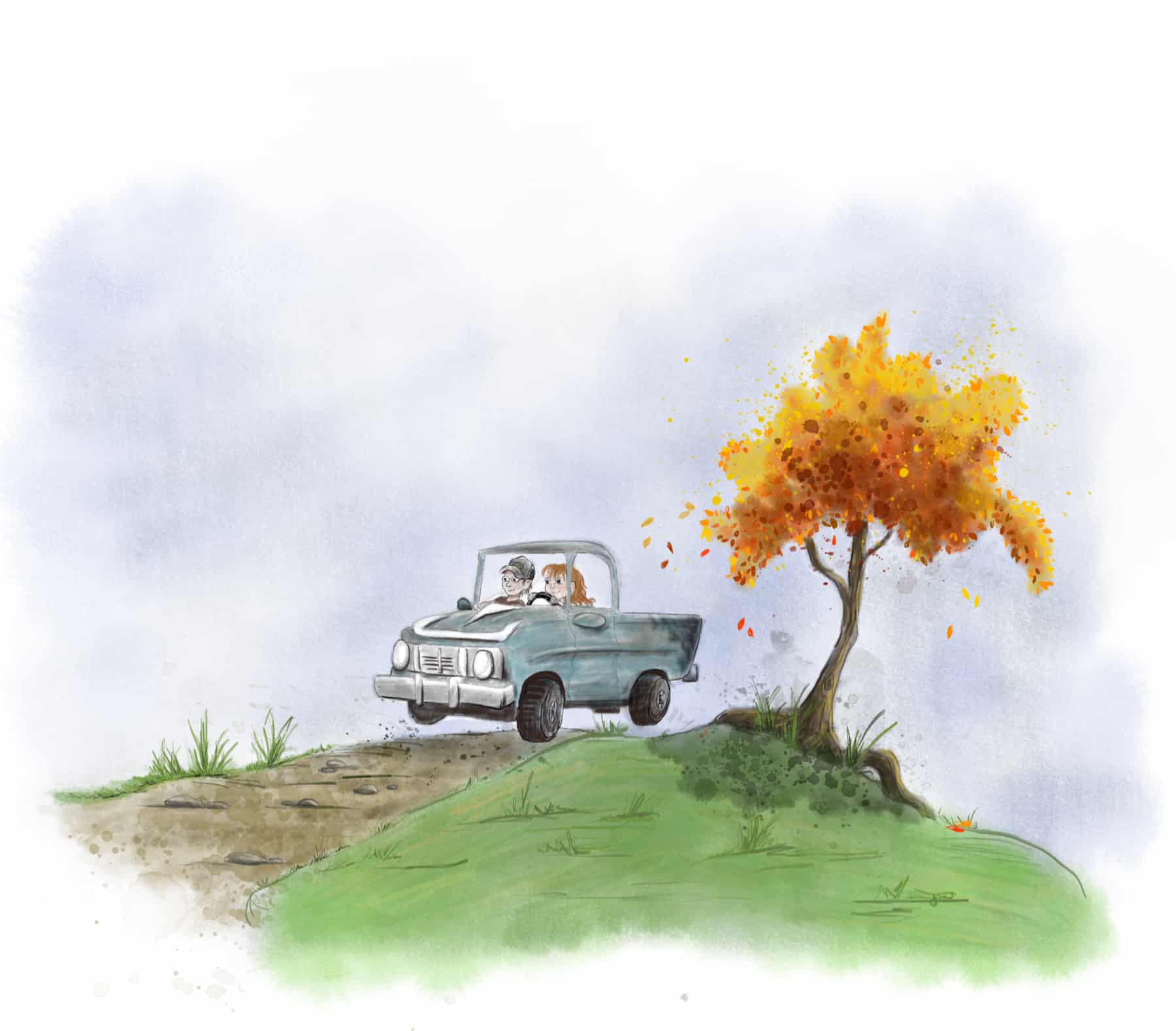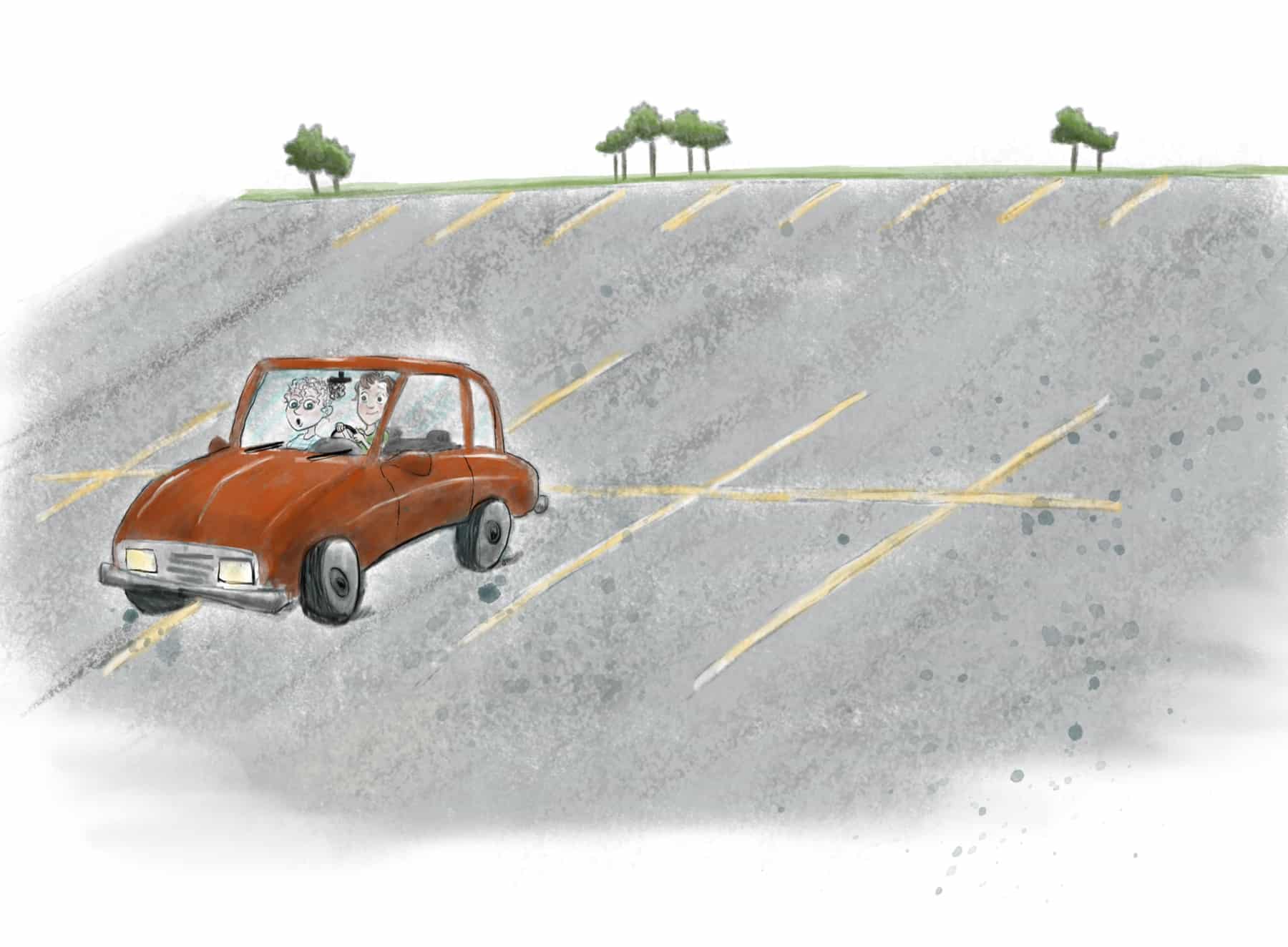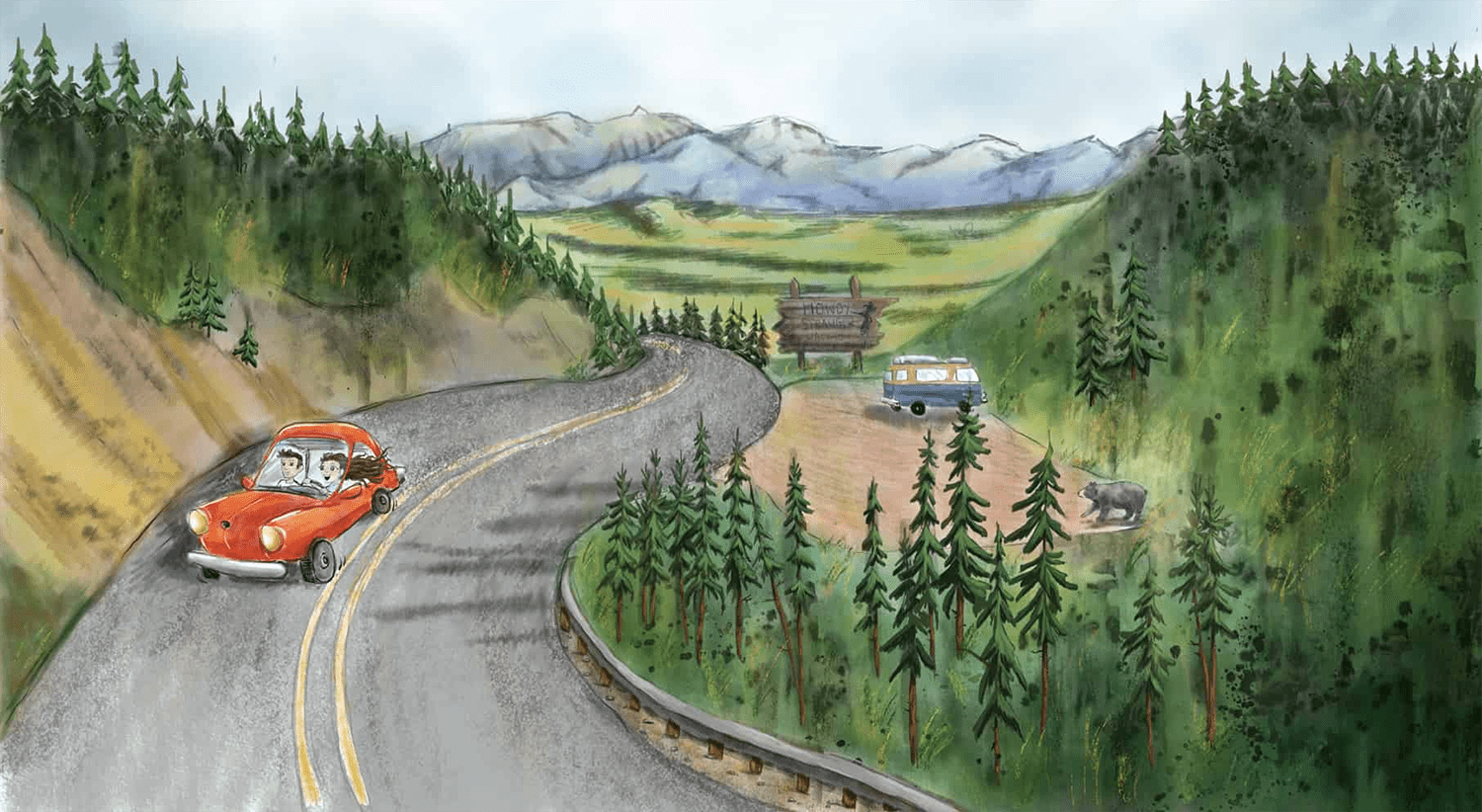By Molly Absolon // Illustrations by Julie Millard
—
it happened so fast.
Meg Woodbury, 15, was riding in a car with a friend this summer when the front wheel flew off the road. Her friend overcorrected, lost control, and drove into a tree. The two girls, both of whom were wearing seatbelts, were fine. The car? Totaled.
When Meg tries to piece together the accident, she has a hard time pinpointing exactly what happened. Was there a slight bend in the road? Maybe. Was her friend distracted? No, but she was tired. Regardless, one minute everything was fine. The next minute, they were off the road, their car crumpled around a tree.

“Life has a way of slapping you down,” Meg’s father, Josh Woodbury, says. “In the process of becoming an adult, you make mistakes that you grow from. That’s inevitable. As parents we do our best to get our kids through that period safely.”
Woodbury learned to drive as a young kid on dirt roads around his hometown in rural Wyoming. He believed that helped him become a better driver, so he had Meg start driving at an early age to allow her to gain experience in a safe, controlled setting. They started in the Mormon Church parking lot in Jackson, and then graduated to deserted dirt roads south of town. By the time Meg took drivers’ education in high school last year, she had more experience behind the wheel than any of the kids in her class. Still, the accident with her friend shook her up. She was surprised how quickly her friend lost control of the vehicle.

Meg knows bad things can happen. Her father’s brother died in a car accident when he was a teenager. She heard the story, but there is a difference between hearing stories and knowing the sound of metal crushing and feeling the abrupt impact of hitting a tree. Stories only go so far in capturing what a car accident feels like.
“Juvenile drivers often overestimate their abilities,” says Deputy Andrew Roundy, who is the school resource officer for the Teton County, Wyoming Sheriff’s Office. “They’ve been riding in cars their whole lives. Most of them have never been in an accident. … They often have no understanding of just how dangerous driving can be.”
Motor vehicle crashes are the second-leading cause of death among teenagers, according to the Center for Disease Control. In 2019, 2,400 teens between 12 and 19 were killed, and more than a quarter million teenagers were treated in emergency rooms for injuries sustained in car accidents. In 2018, the medical and lost work costs from motor vehicle fatalities among teens ages 15 to 19 totaled $4.8 billion, in addition to property damage. The crash risk is particularly high during the first few months after a new driver gets their license. Additionally, the crash rate per mile driven is about one and a half times higher for 16-year-old drivers than it is for 18- to 19-year-old drivers, according to data from the 2016 to 2017 National Household Travel Survey.
Still, most of us survive learning to drive. Roundy believes parents play a critical role in this.
“Driving is fun,” he says. “We like to drive. The way we live dictates that we have to drive. But driving is dangerous. Helping kids understand there is no easier way to die then being careless while driving is critical.”
“Parents can and should give their kids as much training as possible. Drive with them. Coach them. Let them drive in easy conditions. Let them drive in difficult conditions. Share with them good experiences. Share with them bad experiences. Be a teacher. Don’t just turn them loose. Continue to parent and coach every time you are in the car with them, even after they get their license.”



tips for teaching your teen how to drive
- Set a patient, reassuring tone, when driving with your child. Keep your emotions in check. Maintain a calm, even voice at all times.
- Practice the basics, such as backing up, braking, parking, making safe turns, maintaining lanes, signaling to other drivers, and driving at safe speeds for the given conditions.
- Talk about the essentials of how to operate a vehicle—checking fluids, fueling up, adjusting mirrors, inspecting tires, observing dashboard warnings and indicators, etc.
- Teach your child responsibility for driving a vehicle. Have them handle routine maintenance, pay for gas, contribute to insurance coverage, and understand the obligations of caring for a vehicle.
- Make your instructions clear and unambiguous. (For example, only use the word “right” when giving directions.)
- Be attentive and give your teen a lot of advance notice when you want them to change lanes or make a turn.
- Correct your teen’s driving by asking questions. Talk through situations (calmly), and draw their attention to what’s going on.
- Set a policy on listening to music while driving. Make sure your child puts their phone in a place where they cannot be tempted to use it, or turn it off.
- Debrief a drive when you are home and in a safe, neutral setting to help lessons sink in.
Melissa Streubel, whose son Nate, 15, just got his Idaho drivers’ license, says, as he approached driving age, she started using every car trip they took together as a learning opportunity. She’d point out hazards, talk about her decisions, and discuss what she was thinking and doing as she drove. As he got older, she let him take the wheel and coached him as he practiced driving on rural roads.
It wasn’t always perfect, she admits. Nate says his mom was a little more anxious than his drivers’ education instructor, but he also says practicing with her helped him gain critical experience. Like Meg, the fact that he’d been driving on backroads with his parents long before he took a formal class helped a lot.
“It’s kind of funny; I’m a different instructor than I am as a parent,” says Holly Faulkner, the owner of Rocky Mountain Driving School in Idaho Falls. “My son just got his permit, and I find it’s harder to be as patient with him as I am with my students.”
And patience, according to Faulkner, as well as Vicky O’Donoghue, who has been teaching driving for more than 20 years and runs Jackson Hole Driving Academy, is critical.
“Patience helps keep students from getting too nervous,” O’Donoghue says. “When drivers are nervous, they make more mistakes. I’ve been doing this so long I can read my students. I know what they can and cannot do, and I gauge the challenges I present them with accordingly.”

Both Faulkner and O’Donoghue say having their own brake for emergencies gives them added security when they are on the road with new drivers. But they say parents can get around that lack of an extra brake by being alert and thinking like they are behind the wheel at all times, even when they are in the passenger seat. That way, parents stay a couple of steps ahead of their kids and can anticipate problems that would require them to have access to a brake. Faulkner and O’Donoghue also recommend adding complexity slowly. So, start by driving in empty parking lots, move to quiet dirt roads, and only as your teen gains experience and confidence, venture out in traffic, after dark, or in more challenging conditions.
“I do think there are a lot of responsible teenage drivers,” Deputy Roundy says. “Lots of kids understand and make good decisions, but that doesn’t negate the fact that inexperience and being new to driving has an increased risk.”
“If kids understand the significance and responsibility they have when they get behind the wheel, they make wiser decisions,” he says.
local danger zones
→ Jackson
Jackson is busy, the lane markers and crosswalks are faded and hard to see, and there are a lot of pedestrians and bicyclists on the roads. For all these reasons, O’Donoghue sees it as a challenging place for new drivers, and one where they have to be attentive at all times.
→ Highway 33 between Victor and Driggs
Increasing traffic on this two-lane highway, its lack of turning lanes, and the varying speeds of vehicles on the road have led to an increase in accidents along this stretch of highway, including several fatalities this past summer.
→ Other regional challenges
Dark roads, wildlife, winter-weather driving conditions, and distracted driving are other challenges new drivers face on roads in Wyoming and Idaho.
wyoming teen driver’s license requirements
→ Instruction Permit
In Wyoming, teens can apply for an instruction permit at age 15 with required documentation. Applicants can then take the vision test and written exam to obtain their permit. Instruction permits are valid for one year, and may be used to operate a vehicle only under the direct front-seat supervision of a licensed adult.
→ Intermediate Permit
At 16, instruction permit holders can apply for an intermediate permit. Requirements for an intermediate permit are:
- A parent or guardian signature on the application
- A parent or guardian signature on a driving log
- Passing a driving test at a local DMV or driver’s education center
Intermediate permits authorize a teen to operate a vehicle between 5 a.m. and 11 p.m., and only outside these hours when:
- Supervised by a licensed adult
- If required by medical necessity or emergency
- Traveling to and from school
- Traveling to and from work
- Traveling to a religious or athletic activity
Intermediate permit holders are restricted to one passenger under 18, not including family members. The intermediate permit expires 30 days after the holder’s seventeenth birthday.
→ Unrestricted License
An unrestricted license is available to all 17-year-olds. However, teens who have completed driver’s education and held an intermediate license for six months can receive an unrestricted license at 16.5 years old. Curfew and passenger restrictions no longer apply.
→ Hardship License
Wyoming offers a restricted license for 14 and 15-year-olds who can show “extreme inconvenience.” That means, teens who must drive more than five miles for school, work at least 10 hours a week more than five miles away from home, or need a license to help with a family business.
—
idaho teen driver’s license requirements
→ Driver’s Ed
All teens must pass an approved driver education class consisting of:
- 30 hours classroom instruction
- Six hours of behind-the-wheel instruction
- Six hours in-car observation
Students must be at least 14.5 years of age to enroll in driver’s ed, and are only allowed to drive with an instructor during class until they are issued their Supervised Instruction Permit (SIP).
→ Supervised Instruction Permit
- Teens must complete a supervised driving period, which includes:
- No less than six calendar months of supervised driving with a licensed adult
- 50 hours of supervised driving (10 must be at night)
- Supervising driver needs to be at least 21 years of age, and possess a valid driver’s license
→ Licensing
Teen drivers of at least 15 years of age must pass the written knowledge and road-skills test. All drivers must also pass an eye examination and provide required documentation. Applicants who fail a test must wait at least three days before retaking it.
Additional rules:
Drivers under the age of 16 can only drive during daylight hours unless accompanied by a licensed adult driver.
For the first six months from the date of licensing, drivers under the age of 17 cannot have more than one passenger under the age of 18, unless the passenger is related to the driver by blood, adoption, or marriage.
→ Hardship Permit
Teens ages 14 and 15 can apply for a restricted learner’s permit or hardship permit if they live far from their school or job. After 10 days of learning, this permit will allow them to drive during the day within 50 miles of their home.

